The Samsung Galaxy S7 & S7 Edge Review, Part 1
by Joshua Ho on March 8, 2016 9:00 AM ESTSoC Performance
While we’re ready to move on to newer benchmarks for 2016, our system performance benchmarks from 2015 are still going to provide a pretty good idea for what to expect from the Galaxy S7 and Snapdragon 820 by extension. For those that are unfamiliar with what the Snapdragon 820 is, I’d reference our previous articles on the Snapdragon 820.
In essence, we’re looking at a 2x2 CPU configuration with 2.15 GHz Kryo cores for the performance cluster, and 1.6 GHz Kryo cores for the efficiency cluster. Binding the two clusters together are some power aware scheduling at the kernel level and a custom interconnect to handle coherency between the two clusters. Memory is also improved relative to the Snapdragon 810, with a bump to LPDDR4-1866 over the former's LPDDR4-1600. Of course, there's a lot more to talk about here, but for now we can simply look at how the Snapdragon 820 compares in our benchmarks.
Update: As we've had a few questions on the subject, I just want to clarify browser testing. Samsung's stock browser was not included with our Verizon-branded sample phone, nor is it possible to install it at this time. As a result we are unable to test the performance of Samsung's browser. The Verge reports that this is a Verizon decision and that all Verizon phones will be shipping like this; so for these phones Chrome is the de-facto stock browser.
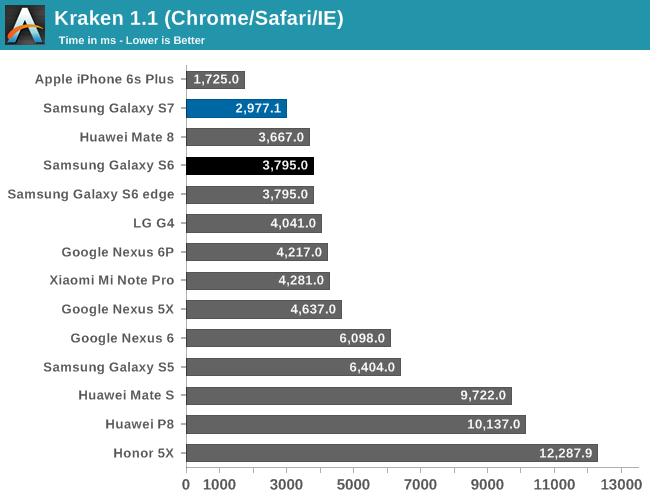

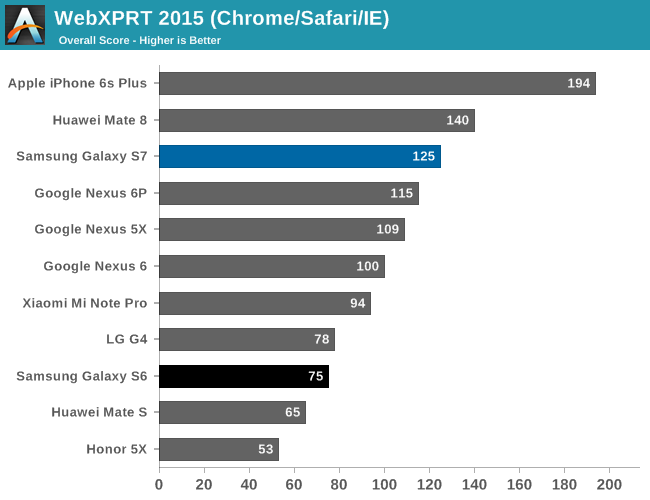
Starting off with our web benchmarks, we can see that in the time since our initial testing of the Snapdragon 820 MDP there have been some major improvements to how well Chrome is optimized for Kryo. As a result we're seeing results that are almost comparable to Snapdragon Browser in Chrome.
Overall then the Galaxy S7 and its Snapdragon 820 SoC won't top the charts on web benchmarks - Apple still holds an edge here - however the Galaxy S7 puts up a solid fight. The one drawback here is that the Mate 8 and its Cortex A72 CPU seems to have the edge over the Galaxy S7.
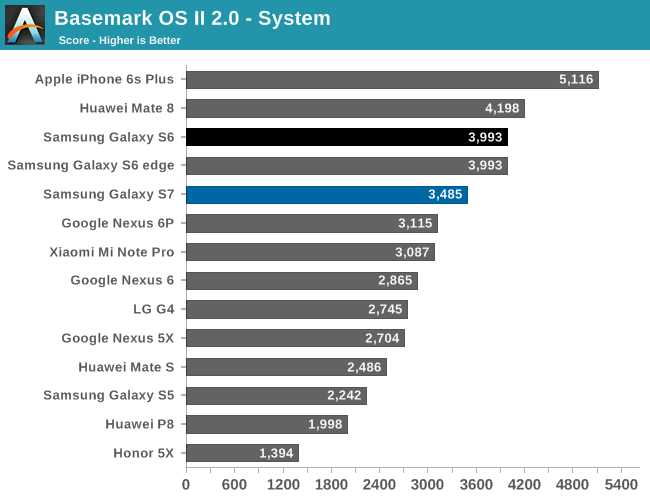
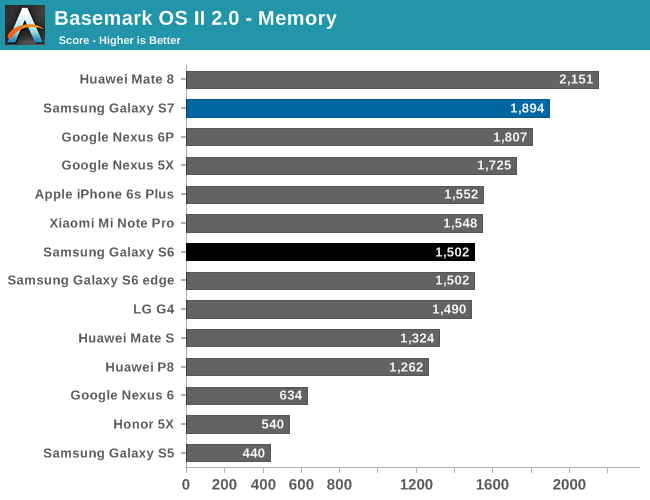
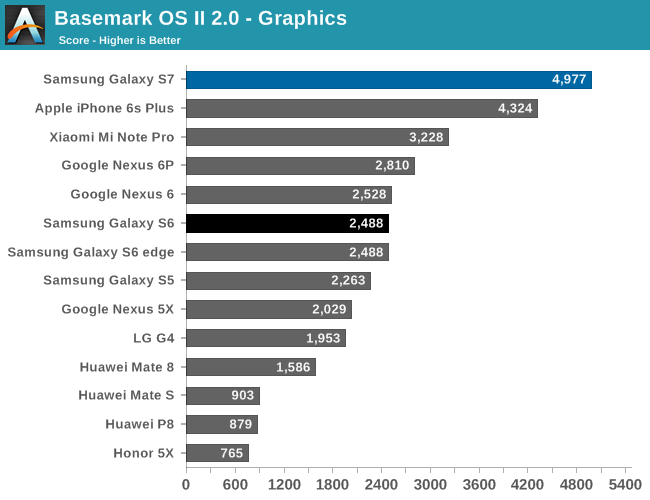
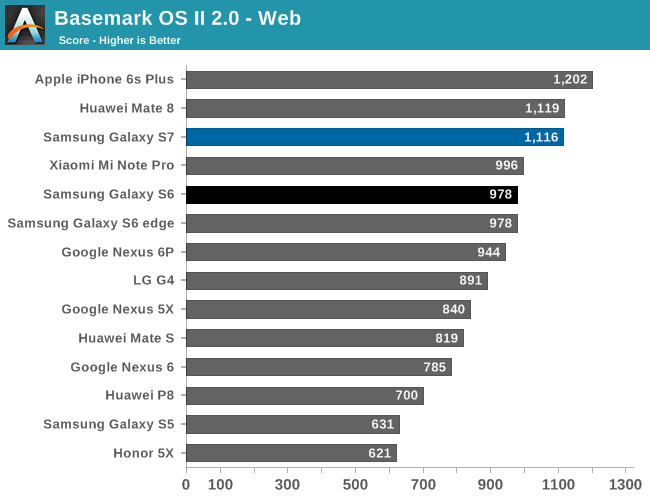
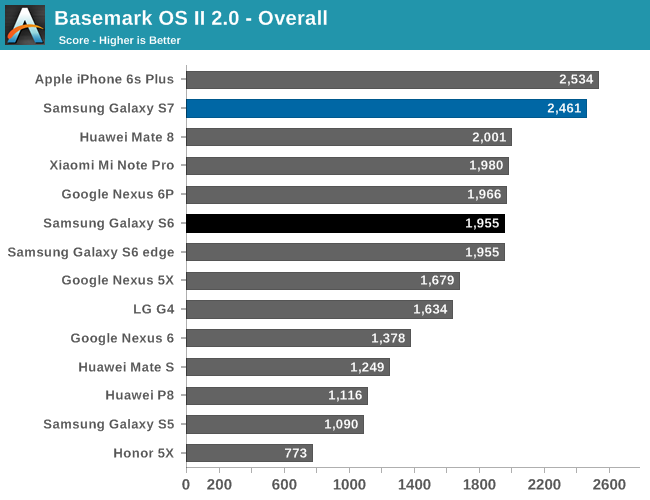
In Basemark OS II the combination of a better GPU, better NAND, and better single thread CPU performance seems to be enough for the Galaxy S7 to approach the iPhone 6s Plus in overall performance. While the system benchmark shows that Kryo isn't quite going toe to toe with Twister, the Adreno 530 helps to narrow the gap in the graphics test.
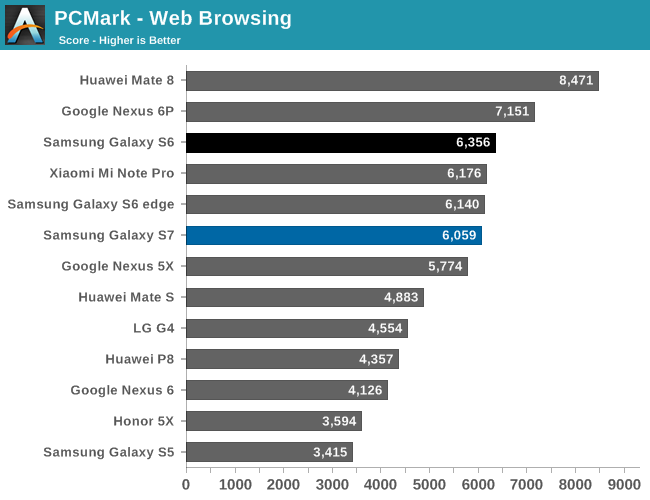
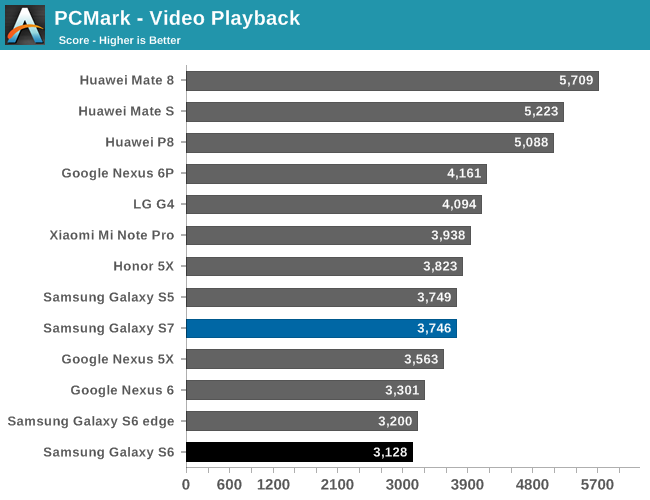


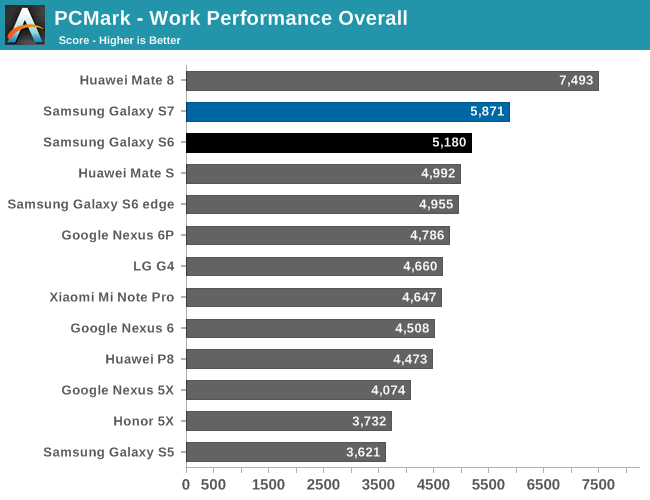
In PCMark, we can see that the Galaxy S7 is mostly comparable to the Galaxy S6. However major improvements in areas like GPU performance help to give it an overall advantage relative to the Galaxy S6 in the photo editing test. Given that this is basically a test of API-level performance, it's likely that Samsung's frameworks and governor settings lead to mostly similar performance in these tests.
Overall, the Snapdragon 820 appears to provide a pretty healthy bump in performance over almost every SoC seen in 2015, although it's hard to declare a clear winner when comparing it to Apple's A9 or Huawei's Kirin 950. If you glanced at the battery life graphs and the performance graphs above it's pretty obvious that Qualcomm has made some enormous strides here. While not quite going from zero to hero, Qualcomm has come close, and that definitely deserves some credit.
NAND Performance
If you think about the memory hierarchy, while RAM and cache are important, at the end of the day the most important aspect is the base storage. Even if you have infinite RAM and cache, if your storage is sufficiently slow the user experience is going to be painful for at least the first time you have to load something.
In order to test this, we use our standard test of AndroBench with 4 KB and 256 KB reads and writes for random and sequential tests. I went ahead and did some digging around to figure out exactly what it is we’re testing in the Galaxy S7, and it turns out that while the Galaxy S7 storage solution is similar to what’s in the Galaxy S6 and S6 edge, it isn’t quite the same. The Galaxy S7 UFS storage identifies itself as the KLUBG4G1CE-B0B1, which looks to be in the same family and appears to have been released at pretty much the same time as the Galaxy S6 storage solution, but the model number isn’t quite the same.
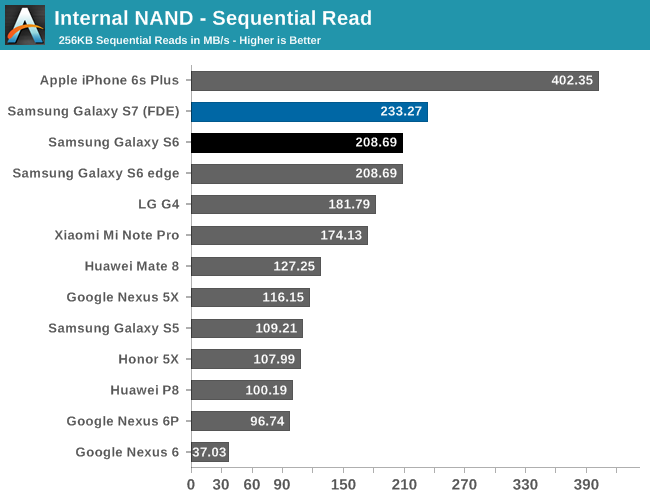
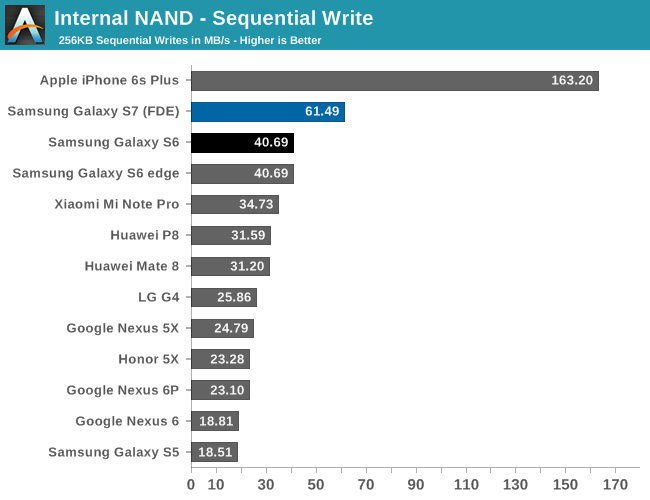
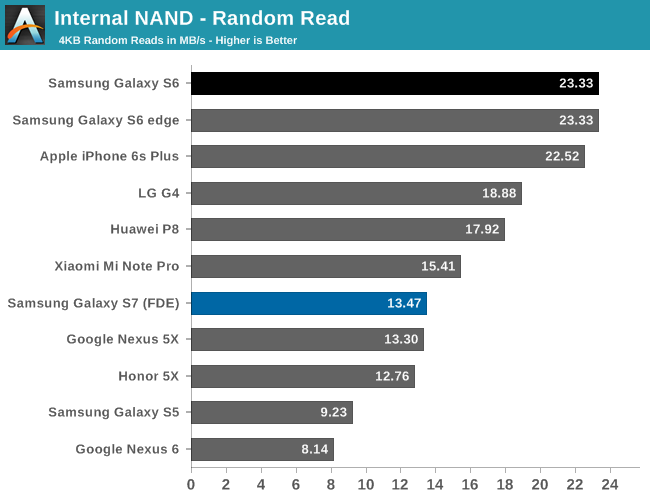
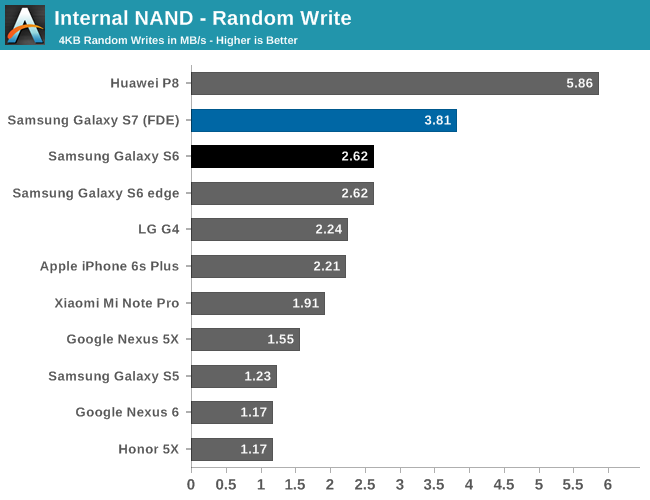
Looking at the performance results, we can also see that the Galaxy S7 is pretty similar to the Galaxy S6 in storage performance at a high level. Interestingly enough despite using full disk encryption on the Galaxy S7, we don’t really see a noticeable degradation in performance relative to the Galaxy S6 which is good to see considering the number of Android devices that do have noticeable performance effects when enabling FDE.










202 Comments
View All Comments
Bluetooth - Wednesday, March 16, 2016 - link
In the NAND storage tests are some phones using decryption and other not?qasdfdsaq - Wednesday, March 23, 2016 - link
As far as I can tell, the S7 comes encrypted out of the box and you cannot turn encryption off, so FDE is its natural and only state.jerrylzy - Wednesday, March 16, 2016 - link
ARMv8 has AES instructions built-in, like AESE (ByteSub, ShiftRows, AddRoundKeys) AESMC (MixColumns), etc.. With this kind of hardware support FDE should not affect much of the NAND performance if Samsung actually uses them.tipoo - Wednesday, March 16, 2016 - link
Ars Technica got something near 100MB/s for random 4K reads, sup with that?jacksonjacksona - Thursday, March 17, 2016 - link
( www).(ajkobeshoes).(com )christian louboutin
jordan shoes $60-
handbag
AF tank woman
puma slipper woman
=====
( www).(ajkobeshoes).(com )
SirKronan - Saturday, April 30, 2016 - link
Please remove spammer...XmppTextingBloodsport - Saturday, March 19, 2016 - link
Good job ignoring both the audio subsystem and antennae functionality of this PHONE.XmppTextingBloodsport - Saturday, March 19, 2016 - link
All LTE phone reviews need an eye to SIP (volte) and their respective audio paths and or black magic deviationsguyhindle - Monday, March 21, 2016 - link
I just *can't* bring myself to drop > £600 on a handset that will last < 3 yearsmaxnix - Wednesday, March 23, 2016 - link
Dumb Comment Time: But one has to note that if Samsung had not abandoned field replaceable batteries, Page one would be a mere curiosity.Coincidentally, I cannot find a review for the original Note Edge. Did AnandTech whiff on this?